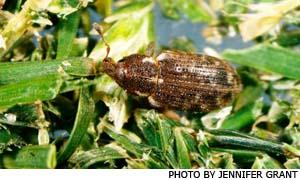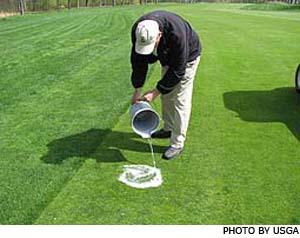 Scientists have learned a lot about annual bluegrass weevils since they first were reported on managed turfgrass more than 80 years ago. But researchers admit there still is much to learn.
Scientists have learned a lot about annual bluegrass weevils since they first were reported on managed turfgrass more than 80 years ago. But researchers admit there still is much to learn.Growing to only 3 or 4 mm in length in the adult phase of its life cycle, this minute pest causes big problems in managed cool-season turf in the northeastern quadrant of the country. And unlike other turf pests, ABW follows few patterns of predictability.
Overwintering adults die and give way to a new generation of adults in late spring or early summer. In some years there are just two life cycles, while in other years there might be three. What sparks an early reproductive cycle from the season's new adults is unknown.
"They're hedgebetters," said Ohio State University entomologist Dave Shetlar, Ph.D. "Some years some go for an extra generation, while others hang onto their eggs and wait until next season."
Likewise, populations in some parts of the northeast have developed resistance to common chemistries, including bifenthrin, while turf managers in other areas still enjoy a full complement of management tools.
"With white grubs, there is one cycle a year, and we always know when it's coming," said Steve McDonald of Turfgrass Disease Solutions. "With annual bluegrass weevil, there might be multiple life cycles in a year, or there might be one, and we don't know exactly when they're coming.
"And there are other chemical pesticides out there that control other pests that are not effective against annual bluegrass weevil. It's a very dynamic pest and there are no absolutes. It breaks all the rules."
According to Cornell University research, ABW first was recorded as a turfgrass pest in 1931 in Connecticut, and its range was limited to metropolitan New York City until the 1990s.
Today, it is considered a turfgrass pest as far west as Ohio and southward to North Carolina. It has been found as far away as Colorado and Oklahoma, but doesn't pose a major problem on golf courses and thus is not considered a nuisance in those areas, said Shetlar.
Emerging typically in late winter or early spring, ABW can persist well into autumn, making it a season-long problem on many golf courses.
The overwhelming percentage of adults overwinter in woody areas, with a smaller number spending the winter in the thatch layer of high-cut turf, says Ohio State's Shetlar.
Historically, they first appear when forsythia are in bloom, but Shetlar said watching for daffodils to burst from the ground might be an even better indicator of ABW activity.
"It can be 40, 45 or 50 degrees," Shetlar said. "It doesn't have to be warm. Sunlight is enough to keep them warm, even if it's still cold out."
Once active, ABW migrate into shorter cut turf, and they prefer fringe areas, such as where fairway meets rough and where collars meld into putting greens. Leaf blades in those areas are thicker, and that is believed to be their preferred meal, Shetlar says. There, they lay their eggs, usually between one and four, in the leaf sheath.
"There is something about the way Poa is managed that they find highly attractive," Shetlar said.
Egg-laying adults soon die, and by the time the newly hatched larvae reach the third instar stage they are too large to stay inside the sheath, and move to and eat around the crown, eventually resulting in the plant's death. Symptoms typically manifest as yellow or browning turf that Shetlar says resembles anthracnose to the untrained eye.
In Ohio, larvae typically develop into adults by late June or early July. In New England, a third generation, if there is one, might appear by late July or early August.
Given the irregular nature of their behavior it's not uncommon to see adults and larvae at the same time, and that can make controlling them a challenge.
"Superintendents panic when they see adults and spray like mad," Shetlar said.
"Some years they double-pump it and there is another generation. No one really knows why it is one way one year, and another way another year."
 McDonald recommends scouting weekly during times of potential activity, including use of soap flushes to detect adults. He also recommends online tools like Syngenta's Weevil Trak, that uses real-time updates from superintendents to monitor weevil activity.
McDonald recommends scouting weekly during times of potential activity, including use of soap flushes to detect adults. He also recommends online tools like Syngenta's Weevil Trak, that uses real-time updates from superintendents to monitor weevil activity.Several products are labeled for ABW control. Shetlar said the pest has developed resistance to bifenthrin in the Northeast with some locations also reporting resistance to chlorpyrifos. Combination products containing chlothianidin and bifenthrin, however, have proven to be very effective, Shetlar said.
"The reality is when you combine two modes of action, often regain efficacy of both molecules, even if there is resistance to one alone," he said.
Shetlar said that legendary Ohio State professor Harry Niemczyk, Ph.D., has conducted research that shows early insecticide applications before the reproductive cycle begins in the spring have been shown to be an effective method of control overwintering adults before they lay their eggs.
"The success rate is about 70 to 80 percent, which is very good control," Shetlar said.
"I don't know of any program that provides 90 percent control 100 percent of the time."

